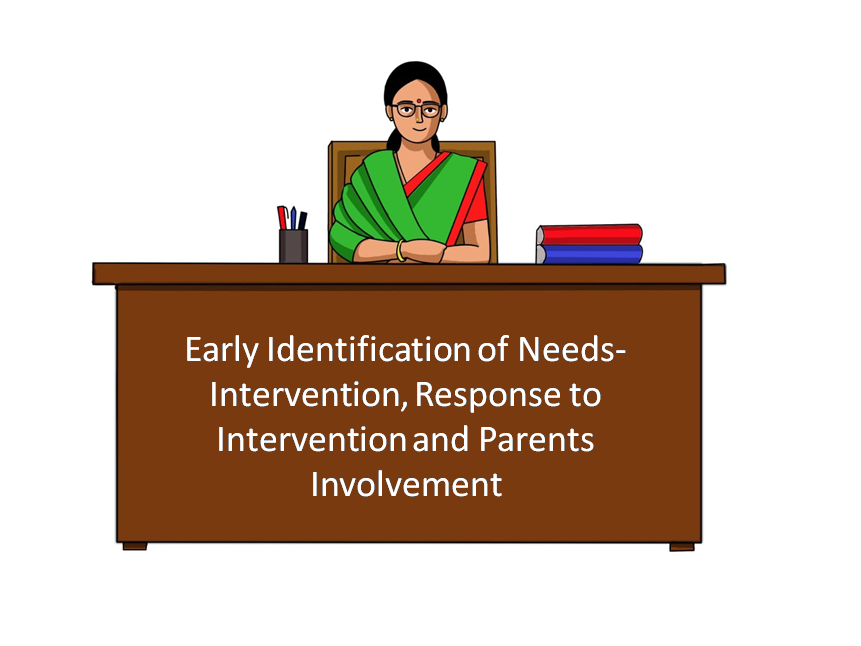
Early Identification of Needs – Intervention and Parent Involvement
Introduction
Early identification of learning/behavioral/social difficulties, the implementation of Response to Intervention (RTI) and active parent involvement are foundational elements in fostering every student’s success.
Addressing potential challenges early can significantly improve academic outcomes, promote equity and reduce long-term struggles for all students. RTI serves as a multi-tiered framework aimed at providing targeted interventions to support the struggling students to avoid over identification of students for special education programs. The parent involvement enhances the collaborative effort required to support students in achieving their full potential. This enabler explores the interconnectedness of these components that form a holistic approach to fostering academic and social/emotional growth of all students and ensuring that no student falls through the cracks.
3.1-The NEP 2020 VISION
“Over 85% of a child’s cumulative brain development occurs prior to the age of 6, indicating the critical importance of appropriate care and stimulation of the brain in a child’s early years for healthy brain development and growth… Investment in ECCE has the potential to give all young children such access, enabling all children to participate and flourish in the educational system throughout their lives. ECCE would be the greatest and most powerful equalizer.” – National Education Policy 2020
The overall aim of ECCE will be to attain optimal outcomes in the domains of physical and motor development, cognitive development, socio-emotional-ethical development, cultural/artistic development, and the development of communication and early language, literacy, and numeracy.” – National Education Policy 2020
For the first time, our national education policy has laid particular stress on the importance of early childhood care and education (ECCE) The implementation of this vision of the policy will naturally create a pathway for early identification of needs and early intervention.
Every child is a child first. Early Intervention, response to intervention and identification of educational needs of students go a long way in helping each child reach his /her own potential. Early identification and recognition of the signs that put students at risk for school failure, and understanding normal developmental and academic milestones help in prompt intervention to support students and their families.
It is imperative that all students struggling at school in the areas of academics/behavior/social interactions receive prompt and intensive support in their areas of deficits to change their learning trajectory. Additionally, this support will assist in avoiding the struggling students from being labelled as disabled. With increased awareness programs, early identification becomes the responsibility of all the stakeholders but the teacher’s role here is very important. Teachers play a crucial role in an inclusive setup by involving all students in all scholastic and co-scholastic activities and regularly evaluating growth. If the educators do not utilize effective instructional practices in an inclusive classroom, the students with special needs may end up experiencing school failure.
3.2- Early Intervention
- Early intervention is a term used for interventions provided to infants and toddlers with developmental delays. However, in this document, this term used to describe services and support that help young school aged children with developmental delays or at risk of failing in schools.
- Early identification and recognition of the signs that put students at risk for disabilities, and understanding normal developmental milestones helps in prompt intervention to support children and their families so that issues are tackled before they become more serious problems.
- Early intervention can have a positive impact on a child’s ability to learn new skills and increase their success in school and life.
- Early intervention in schools may include intensive academic support, speech therapy, occupational therapy, physical therapy, social skills training, behavioral therapy and other types of services based on needs of the child.
3.2.2- Why Early Intervention is Important?
Early intervention in schools refers to a set of proactive effective strategies and targeted support systems designed to identify and address academic, developmental, or behavioral challenges in students during their early years of education. The primary goal is to intervene promptly when signs of difficulty arise, with the aim of preventing these challenges from becoming more significant barriers to a student’s progress.
Early intervention in schools is essential for setting a solid foundation for a child’s future academic success and overall well-being. By identifying and addressing challenges early, educators can create a supportive and inclusive learning environment that maximizes each student’s potential.
3.2.3- Key Components of Early Intervention
- Identification of Needs: Early intervention starts with the identification of students who may be at risk of or experiencing challenges in their learning, behavior, or social development. This identification can involve assessments, observations, and collaboration among teachers, parents, and specialists.
- Individualized Support: Early intensive three tiered intervention programs are designed to provide individualized support based on the unique needs of each student. This may include personalized learning plans, targeted interventions, and differentiated instruction to address specific challenges. Individualized support is provided at three tier levels.
- Multidisciplinary Collaboration: Early intervention often involves collaboration among parents and various professionals, such as teachers, special education specialists, speech therapists, occupational therapists, psychologists, and other specialists. This multidisciplinary approach ensures a comprehensive understanding of a student’s needs and effective support.
- Preventive Focus: Early intervention is preventive in nature. By addressing challenges early on, educators aim to prevent the development of more significant issues that could impact a student’s academic, social, or emotional well-being.
- Holistic Development: Early intervention programs often target various aspects of a child’s development, including cognitive, language, motor skills, social-emotional, and behavioral domains. The goal is to foster a well-rounded and positive learning experience.
- Data-Informed Decision-Making: Data, including assessments, observations, and progress monitoring, play a crucial role in early intervention. Educators use data to inform their decisions, track progress, and adjust interventions as needed.
3.3- Response to Intervention (RTI)
1. Universal Screening: At the beginning of a new school year, schools assess all students using standardized screening measures to identify those who may be at risk or is struggling academically. These assessments help to identify areas of concern and determine the appropriate level of intervention. (Schools can use PRASHAST screening tool of NCERT) Utilizing screening tools for early identification of deficits, subsequently providing response to intervention strategies and using a collaborative approach will significantly enhance success
2. Tiered Instructional Levels: RTI operates on a multi-tiered system of support. Students are provided instruction and interventions at different levels based on their individual needs.
Tier 1 involves high-quality, evidence-based core instruction provided to all students in the general education classroom. At this tier, the teachers utilize research-based teaching strategies such as universal design for learning, differentiated instruction, and collaborative learning. Such innovative, child-centered practices enhance the learning experience for all students. Hopefully, some students with difficulties will demonstrate progress.
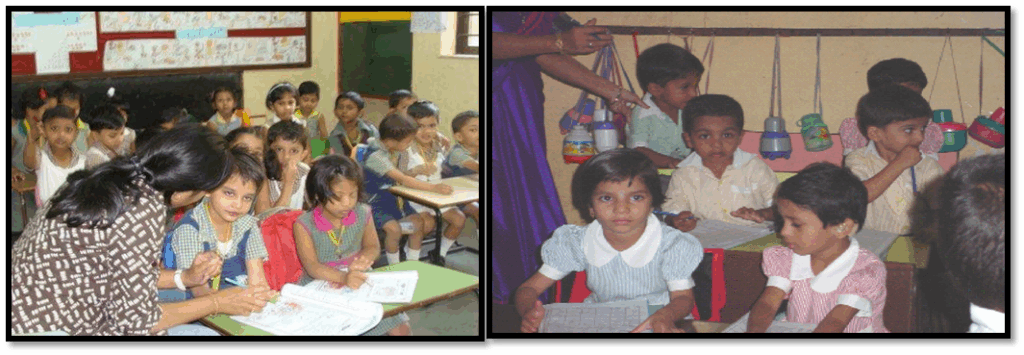
Innovative child-centered practices to enhance learning for ALL children
For the students who continue to struggle, teachers will start to provide Tier 2 and 3 interventions. At these tiers, teachers will provide increasingly intensive and targeted interventions provided to students who require additional support beyond the core instruction. For example, a student continues to struggle in reading decoding despite the teacher utilizing different teaching strategies in the classroom. In this case, now the teacher needs to increase the frequency and provide more intensive reading intervention on an individual level or in a small group after school hours.
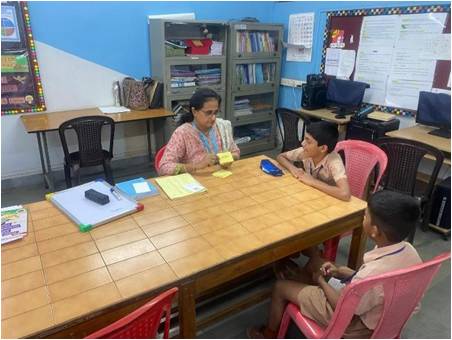
More frequent, targeted interventions-individually or in small groups
3. Progress Monitoring: Continuous progress monitoring is a crucial component of RTI. Students’ progress is regularly assessed to determine the effectiveness of the interventions and instructional approaches being used. This data helps educators make data-informed decisions about the need for further intervention or adjustments to the strategies employed.
4. Data-Based Decision Making: The RTI framework emphasizes the use of data to make informed decisions. Educators analyze the collected data to identify patterns, trends, and areas of improvement. This data-based decision-making guides the selection of appropriate interventions and modifications to instruction to better meet students’ needs.
5. Collaboration and Teamwork: Effective implementation of RTI requires collaboration and teamwork among educators, administrators, support staff, and families. Through collaboration, educators share expertise, discuss student progress, and collectively plan interventions to ensure consistency and coherence of support across different settings.
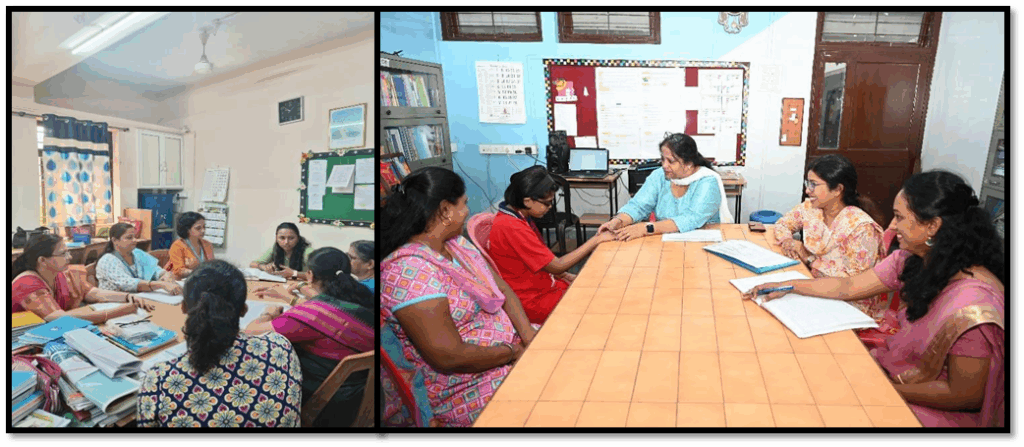
Collaboration – educators, administrators, parents and students
6. Individualized Interventions: Based on students’ progress and response to the interventions, individualized support plans are developed for those who require more targeted support. These plans outline specific goals, interventions, and strategies tailored to each student’s needs.
7. Continuous Support: RTI is an ongoing process, ensuring that struggling students receive the necessary support on a continuous basis. As students’ progress, the level of intervention may be adjusted accordingly, ensuring that they receive the appropriate level of support as needed.
RTI is a proactive approach that aims to prevent long-term academic difficulties and provide timely and targeted interventions. By implementing this framework, schools can better support struggling students and provide them with the tools and resources they need to succeed academically, behaviorally, and socially.
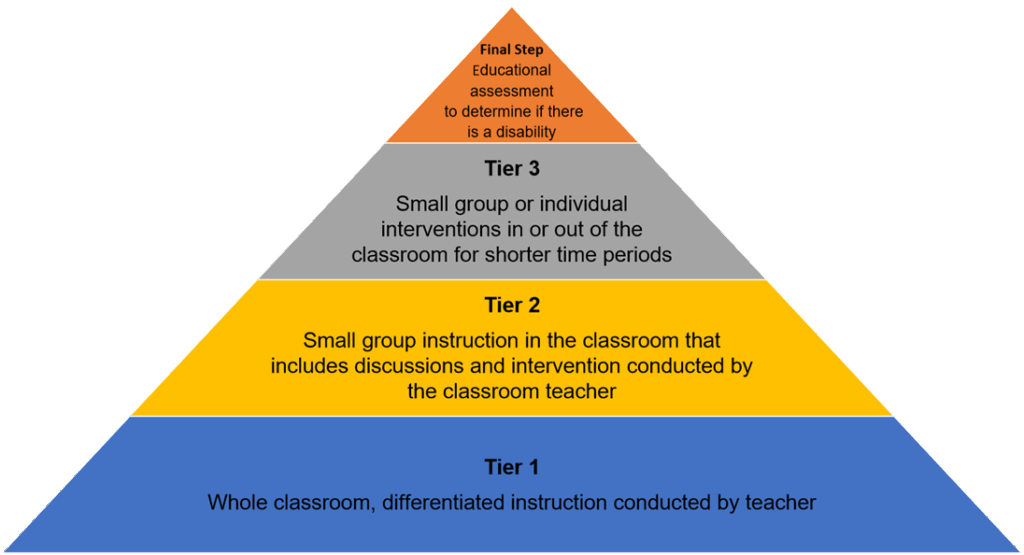
3.3.2- Understanding tiered instructional levels
A) TIER 1: The key overall thrust of curriculum and pedagogy reform across all stages will be to move the whole education system towards real understanding and learning how to learn. As stated in NEP2020, “Curriculum content will be reduced in each subject to its core essentials, to make space for critical thinking and more holistic, discovery-based, discussion-based, and analysis-based learning. The mandated contents will focus on key concepts, ideas, applications, and problem-solving. Teaching and learning will strive to be conducted more interactively; questions will be encouraged, and classroom sessions will regularly contain more fun, creative, collaborative, and exploratory activities for students for deeper and more experiential learning.” (National Education Policy 2020)
Effective Teaching/Intervention Strategies to support the struggling students at Tier 1:
- Know Your Pupils and Develop Their Respect.
- Utilize with fidelity, research based instructional strategies like, universal design for learning, differentiated instruction
- Use Summative and Formative Assessments
- Utilize Explicit Instruction
- Use Effective Questioning Techniques
- Use Collaborative Learning
- Teach Thinking Skills & Problem-Solving Techniques
- Utilize Modelling and Scaffolding
If these strategies are implemented with fidelity, it will result in meeting the educational needs of all students in the classroom.
B) TIER 2: Even when the educators are utilizing effective instructional strategies, 10-15% of the students may continue to struggle in an inclusive setting. At this level, educators may utilize small group standards-based interventions that are incorporated into general classroom instruction. (Useful resource: Nine types of Adaptations. PDF (resources.finalsite.net))
Effective Interventions:
Reading Interventions
- Small Group Instruction – Students receive instruction in small groups (3-5 students) focused on specific skill deficits.
- Repeated Reading – Students read passages multiple times to build fluency.
- Phonemic Awareness and Phonics Instruction – Direct instruction in decoding, blending, and segmenting words.
- Explicit Vocabulary Instruction – Teaching new words through direct instruction and repeated exposure.
- Comprehension Strategies – Teaching strategies like summarization, visualization, and questioning.
Math Interventions
- Small Group Instruction – Reinforcement of foundational math concepts.
- Use of Manipulatives – Hands-on tools like blocks and counters to support understanding.
- Explicit Problem-Solving Instruction – Teaching step-by-step problem-solving techniques.
- Fact Fluency Practice – Repeated practice of basic addition, subtraction, multiplication, and division facts.
- Error Analysis and Feedback – Identifying mistakes and providing corrective feedback.
Behavioral and Social-Emotional Interventions
1. Check-In/Check-Out (CICO) – A structured mentoring system where a student checks in at the beginning of the day and checks out with the teacher at the end of the day.
An example to illustrate how this intervention works.
| Radha is in the 2nd grade. She struggles with staying on a task and waiting for her turn. She is always out of her place. The school along with parents decide to try CICO. CHECK IN- Next morning when Radha arrives at school, Teacher: (With a warm smile) Good morning Radha ! Look what I have for you. Radha: Good morning teacher! What is that in your hand? Teacher: (Hands over ‘a behaviour goal sheet’) This is what you’ve got today. It says, STAY ON TASK and RAISE YOUR HAND TO SPEAK. Every time you do these two things today, you’ll get a surprise! Radha: Surprise! (smiles) During the Day: teacher gives quick feedback each period (stars,smiley face, thumbs up/down, or points. CHECK OUT- End of the school day, Radha stays back to meet teacher again. She reviews her sheet with teacher. Teacher: Good! Radha, you have 8 stars for waiting for your turn and 5 stars for staying on a task today. I am proud of you. Shall we try this again tomorrow? Radha: (nods and smiles). May I take this to show mamma? Sheet goes home for parent’s signature. Purpose of this intervention: Builds routine, positive attention, and accountability in a supportive way. |
2. Social Skills Groups – Small group instruction focusing on skills like communication, cooperation, and self-regulation. This intervention is extremely beneficial for students with poor social skills especially the ones with autism. For example,
| To teach a student appropriately to initiate a conversation with a classmate during free play or recess. Step-by-Step Teaching Plan: Step 1 – Introduce the Skill (Direct Instruction). Use simple language and visuals- When you want to talk to someone, first say ‘hello’. Then ask a question like, ‘Do you want to play with me?’” Step 2 – Model the Skill using ‘Role-plays’ with puppets. Puppet 1: “Hi! Do you want to play with me? Puppet 2: What do you want to play with? Puppet 1: (Shows building block) do you want to build with blocks? Puppet 2: Yes! Step 3 – Practice with child (Include pictures for each step). Step 4 – Practice with the child, teacher and peers in a quiet setting. Step 5 – Reinforce, Remind and Prompt in natural settings like recess time. Step 6 – If the child tries, immediately praise: “Great job! You started well!” Step 7 – Review and Reflect: After the interaction, ask: “How did it go? How did your friend respond?” Help the child to label feelings. You Can Use. Visual cue cards as tools for this. |
3.. Positive Reinforcement Programs – Reward systems that reinforce good behavior (e.g., token economies, Positive Behavioral Strategies such as praising the students who are on task which will encourage students off task to start focusing).
4.. Self-Monitoring Strategies – Teaching students to track their own behavior or academic performance.
5.. Conflict Resolution Training – Teaching students strategies for managing conflicts constructively. Poor conflict resolution skills result in students’ inability to build and maintain relationships.
Executive Functioning and Study Skills Interventions
Executive functioning helps children plan, focus, remember instructions, and control their behavior. When young children (ages 5–10) have deficits in executive functioning, they may forget steps in a task (like getting dressed or completing a worksheet). They have trouble starting or finishing work. They lose things easily (like pencils or homework). They also get easily distracted. They have trouble waiting their turn or controlling emotions. Also, they struggle to follow multi-step directions. These children often want to do well, but their brains need more help organizing their thoughts and actions. Lack of support and interventions in early years results in these children failing in schools and may be mislabelled as students with special needs.
Examples of interventions:
1. Visual Schedules: Use pictures or checklists to show the steps of a task (e.g., unpack backpack, hang jacket, sit down). This helps with memory and sequencing.
2. Break Tasks into Small Steps. Give one direction at a time. Use short, clear instructions.
3. Use Timers. Set visual or sound timers to help with time awareness. E.g., “You have 5 minutes to clean up.”
4. Graphic Organizers: Help kids organize their thoughts when writing or solving a problem. Examples: webs, charts, or boxes.
5. Checklists for Routines: Morning routine, packing up at the end of the day, etc. Let children check off each step.
6. Model and Practice Self-Talk: Teach children to say, “What do I need to do first?” or “Stay focused.” Reinforces metacognition (thinking about thinking).
7. Teach Planning with Visual Aids: Show how to plan a story, break down a project, or solve a math problem.
8. Use Praise and Positive Reinforcement: Celebrate small wins like “You stayed focused for 10 minutes!” This encourages repeated effort.
9. Teach and Practice Emotional Regulation: Use calm-down areas, breathing techniques, or feelings charts. Helps with impulsivity and frustration.
10. Provide Repetition and Routine: Structure and consistency reduce stress and support memory.
Children with executive functioning difficulties can learn and succeed — they just need strategies and support that build their skills step by step. Early intervention makes a big difference! If intervention is not provided in time, these children may be misidentified as students with special needs.
These Tier 2 interventions listed above are typically provided 3-5 times per week for 20-30 minutes and are monitored through progress tracking. If a student does not respond to Tier 2 interventions, they may receive more intensive Tier 3 support.
C) TIER 3: 3-5% of students may continue to struggle after receiving tier 1 and 2 support and will require intensive support on Individual basis or in a very small group. Tier 3 interventions are the most intensive level of support in the RTI framework. These interventions are highly individualized, often provided one-on-one or in very small groups (1-3 students). They are data-driven, research-based, and often require more frequent progress monitoring. Teachers may implement the above listed intervention programs, but the frequency and intensity of the support changes.
Key Interventions at Tier 3:
- Highly Individualized: Designed to meet the specific needs of the student.
- More Frequent Sessions: Often provided daily or several times a week.Reading – Students read passages multiple times to build fluency.
- Smaller Awareness and Phonics Instruction – Direct instruction in decoding, blending, and segmenting words.
- Data-Driven Progress Monitoring: Regular assessment to adjust interventions as needed.
- Involves Specialists: May include special education teachers, reading specialists, speech therapists, counselors, and behavioral specialists.
- May Lead to Special Education Referral: If a student does not respond to Tier 3 interventions, an evaluation for an Individualized Education Program (IEP) may be considered.
If after all three Tiers have been implemented with fidelity and the students continue to struggle, then the student should be considered for special educational assessment and services.
3.4- Parental Involvement
Parents are integral to the early intervention process. Family involvement is encouraged to create a collaborative partnership between educators and families. This collaboration ensures a consistent and supportive approach. An often-overlooked but essential aspect of this process is the involvement of parents.
3.4.1-Benefits of Parental Involvement:
Enhanced Information Sharing: Parents possess unique insights into their child’s behavior, learning styles, and developmental history. Involving parents in the early identification process allows educators to gather comprehensive information that may not be apparent in the classroom alone. Additionally, parents can be trained to implement the same interventions at home that are implemented by school. This holistic view ensures a more accurate and nuanced understanding of the child’s needs and helps the child to generalize skills in all settings.
Improved Communication and Collaboration: When parents are active participants in the identification process, it fosters open communication and a partnership mindset between home and school. This collaborative approach ensures that both parties are aligned in their goals and strategies, leading to more consistent and effective support for the student.
Increased Advocacy and Support: Parents are natural advocates for their children. By involving them early, schools empower parents to understand the identification process, the available resources, and the specific needs of their child. Informed parents are better equipped to advocate for appropriate interventions and support both within and outside the school setting.
Strengthened Trust and Engagement: Building trust with parents is crucial for the success of any intervention plan. When parents feel heard and valued as partners in their child’s education, they are more likely to engage positively and support school initiatives. This trust extends to the student, who benefits from a unified and supportive network.
Intensified support is provided at school and home when parents and educators are implementing the same interventions.
3.4.2- Strategies to improve Parental Involvement:
- Frequent communication: Use open communication channels (emails, phone calls) to update parents of their child’s progress.
- Gather information from parents regarding their child’s early developmental history, school history, study habits, home environment etc.
- Acknowledge parents’ concerns and perspectives while offering constructive support.
- Educate and empower parents by providing them with the strategies that are being utilized by the teacher to support their struggling child.
- Involve parents in creating and reviewing intervention plans. In addition to training parents only with the methods we use in school, we should always ask parents-” How do you think your child can learn this better?” The school may get a different perspective to add to its basket or the school may realize that the child is a first-generation learner or that he has no support system at home. Here, the role of the teachers becomes even more important and the intervention levels have to be slow paced and repetitive.
- Keep parents motivated by showcasing progress by highlighting achievements of their child.
3.5 Case Scenarios:
These scenarios emphasize the importance of implementing early interventions utilizing structured early intervention framework like RTI to identify and support students facing academic or behavioral challenges, thereby enhancing their chances of success.
Scenario 1: Successful RTI Implementation
| Background: A Sr.KG student, Arya, in an English Medium school, struggled with identifying and reading letters of the English alphabet, while most of the others in the class could read, write and spell four letter words. They could read short sentences too! Intervention: Arya’s school employed an RTI framework, initially by providing extra attention and a buddy in the classroom. (Tier 1). Noticing her difficulties, educators collaborated with her parents who reported that Arya has a history of ear infections and subsequently frequently missed school. They also shared that Arya spent the entire day with grandparents and a maid. None of them spoke or read English. The school team decided to move Arya to Tier 2, offering targeted small-group reading sessions. Parents implemented the same reading strategies at home. Progress monitoring indicated limited improvement. Parents and the school decided to move Arya to Tier 3, where she received individual focused support more often and after a couple of months, Arya was able to read, write and spell small words. Outcome: Over time, Arya’s reading improved significantly, bringing her up to grade level. The structured RTI collaborative approach facilitated early identification and support, preventing further academic decline. |
Scenario 2: Successful RTI Implementation
| Background: Mahesh, a second-grade student, exhibited behavioral challenges, frequently disrupting class and struggling with peer interactions. Intervention: The school applied the RTI model to address behavioral issues. Initially, universal behavioural expectations and supports were reinforced (Tier 1). As Mahesh’s behaviour continued to be problematic, he was provided with targeted interventions (Tier 2), including small-group social skills training and a behaviour monitoring plan. Parent interview revealed that Mahesh exhibits behavioural problems at home and in the neighbourhood. The team of educators and parents agreed to intensive, individualized support (Tier 3), such as one-on-one counselling and a personalized behaviour intervention plan. The parents learned the behaviour interventions and consistently implemented the behaviour plan with fidelity at home. Outcome: With consistent monitoring and support, Mahesh’s behaviour improved in all settings, leading to a more positive behaviour at home/classroom and better academic performance. |
Scenario 3: Lack of Interventions Leading to misidentification
| Background: Shanti, a first-grade student, had difficulty grasping numerical concepts, often falling behind her peers. She is a first- generation learner and there was no learning support at home. She started attending school only at the age of six. She lives at home with her single mother and two younger siblings. Absence of Intervention: Shanti’s school lacked a structured intervention framework like RTI. Her struggles were attributed to a lack of effort, and she did not receive additional support beyond regular classroom instruction. Her teachers labeled Shanti as an unintelligent and lazy student. Outcome: Without targeted interventions, Shanti’s difficulties persisted, leading to frustration, decreased confidence, and eventual failure in learning numeracy concepts as well as the other students in class. Her struggle in school continued for the next three years and in the fourth grade, Shanti was given the label of a ‘slow learner’ who will always find Mathematics difficult. |
Scenario 4: Lack of Interventions Leading to dropping out of school
| Background: Shyam, a second-grade student, displayed signs of reading and writing deficits. Being an intelligent auditory learner, he managed to somehow complete primary school. There was little support from his father, who was a clerk in the post office, striving to make ends meet. Mother could hardly help Shyam in coping with his deficits for she did not know how to help. Absence of Intervention: In the absence of an RTI framework, Shyam’s challenges were not systematically identified or addressed in school. He continued to receive standard instruction without targeted support. Outcome: Shyam’s reading and writing difficulties remained unaddressed, resulting in poor academic performance, low self-esteem, and disengagement from learning. Shyam dropped out of school at the age of 11. |
SUMMARY:
| Source and Attribution of images All images used in the above Assets and Aids are originally created. |
| This digital material has been developed by the Sri Sathya Sai Vidya Vahini Inclusive Education Project, a unit of Sri Sathya Sai Central Trust, Prasanthi Nilayam, as a collaborative offering in the service of our nation. |